Overall Life Cycle Comprehensive Assessment of Pneumatic and Electric Actuator
ZHANG Yeming and CAI Maolin
1 School of Mechanical and Power Engineering, Henan Polytechnic University, Jiaozuo 454000, China
2 School of Automation Science and Electrical Engineering, BeihangUniversity, Beijing 100191, China
1 Introduction
Most electricity energy of industrial and mining enterprises was consumed by mechanical and electrical equipment. So far, questions about electromechanical products evaluation of manufacturing industry are still a few new topics to explore. Although the domestic and international research data and papers in recent years provide life-cycle cost (LCC), life cycle assessment (LCA),environmental impact assessment (EIA)[1], environmental management System (EMS) and product evaluation methods such as green degree[2–3], but the results are mainly from the environmental point of view or design methodology, analysis and evaluation of the product life cycle for the material and energy use, waste discharge and treatment impact on the environment , toxic and hazardous waste identification and green degree of products, their research has remained mostly qualitative research, the research results can be less repetitive operation[4–6].Currently, there is little research about the electromechanical products assessment for the green design optimization and excellent selection. And there is little research about Life cycle assessment studies of pneumatic system, and pneumatic actuators and electrical actuators comprehensive evaluation and quantitative comparison.
Pneumatic actuators and electric actuators are all very widely used in automatic production line nowadays.Cylinder driving systems since the1970s in the field of industrialization have been rapidly spread out in many manufacturing factories[7]. Cylinders mainly applies in reciprocating linear motion field, in particular, applies to the workpiece straight line transmission occasions. Now,cylinders have become the mainstream of the actuator in the field of industrial production in PTP (point to point)transmission occasions[8]. In recent years, China’s annual growth rate of the cylinder volume has been maintained above 20%.
Electric actuators are mainly used for rotating and oscillating conditions. Electric actuators for the linear removal conditions are on the rise in recent years. Electric actuator enables high-precision multipoint orientation.Pneumatic actuator is very difficult to achieve it.
With the progress of the electronic science and technology, electric actuator systems appear and are contesting with pneumatic actuator systems in some pneumatic application field. Pneumatic actuator consumes compressed air and electric actuator consumes electricity power. In the selection of pneumatic actuator and electric actuator, especially in the most PTP transmission occasions of industrial automation, has not been sufficient data to describe their selection and assessment criteria up to now.
This paper proposes a novel analysis and assessment method for pneumatic & electric actuators. The proposed method makes it possible to compare and analyze two kinds of actuators’ good and bad comprehensively. The method is named as overall life cycle comprehensive assessment (OLCCA).
In this research, OLCCA configure for pneumatic actuators and electric actuators are analyzed and explained in section 2. OLCCA configure for actuators mainly includes three parts: (1) mechanical properties evaluation(MPE) for the two kinds of actuators, (2) life cycle cost analysis based on users(LCCABOU) for the two kinds of actuators, (3) life cycle environmental impact assessment(LCEIA) for the two kinds of actuators. In section 3 actuators MPE algorithm of based on information entropy is proposed and analyzed. In section 4 actuators LCCABOU model of based on information entropy is established and verified by actual application case of actuators. Consequently, LCEIA method and procedure for actuators are presented in section 5, followed by discussions and conclusions.
2 OLCCA Configure for Actuators
Pneumatic and electric actuators are all mechanical products. They all have advantage and disadvantage mechanical characteristics in different application fields.Mechanical properties of two kinds of actuators can be analyzed by MPE algorithm. As a commodity, pneumatic &electric actuators all have economic properties. The two kinds of actuators’ economic properties can be analyzed by the LCCABOU method. Moreover, pneumatic & electric actuators will consume energy and material when they are manufactured or running in industries field. Therefore, they will cause environment impact to some extent in their overall life cycle from manufacturing to recycling. The two kinds of actuators’ environmental properties can be analyzed by the LCEIA method.
The OLCCA configure of two kinds of actuators presented in this paper is shown in Fig. 1. With algorithms of Fig. 1, many important conclusions of two kinds of actuators’ characteristics will be generated. These advantage or disadvantage characteristics of the two kinds of actuators will be applied to decide or assess which kind of actuators is superior to the other kind of actuators.

Fig. 1. Configuration of OLCCA for pneumatic & electric actuators
3 MPE of Pneumatic and Electric Actuators
Pneumatic and electric actuators have a lot of mechanical properties, such as mass, volume, load capacity, work stroke, speed, positioning accuracy, etc. Evaluation of mechanical properties of the actuator in mathematics belongs to multi-objective decision-making problem[9]. Fig.2 shows the multi-objective solution selection hierarchy of pneumatic and electric actuator.

Fig. 2. Example of actuators’ multi-objective solution selection hierarchy
Multi-objective (attribute) decision-making problem can be described as: Given a solution sets M, M=[M1, M2,…,Mj]T, and each solution Mi, Mi=[mi1, mi2,…, min], as

And Eq. (1) can be described as the following equation for pneumatic and electric actuator:

The evaluation aim is to select the most appropriate solution through a series of evaluation strategies from the solution sets[10].
3.1 MPE algorithm of actuators based on information entropy
When in actuator solution selection , actuator needs to satisfy the actual working condition and is considered from work trip, load capacity, mass, volume, speed, running power, power density ratio (the ratio of operating power and density), as well as life, positioning accuracy and other factors[11]. Among these properties, mass, volume, running power, power density ratio, positioning accuracy are cost-type properties (contrarian indicator), such as the mass property, the lighter the better. Work trip, load capacity,speed, life was efficiency-type properties (positive indicators), such as the life property, the longer it is, the better it is[12]. Fig. 3 shows the MPE algorithm model.

Fig. 3. MPE algorithm flowchart of actuators based on information entropy
In the MPE model presented in this paper, an attempt is made to combine the multi-criteria decision making theories with the fuzzy sets theory and information entropy.MPE and selection process of actuators begins with the specification of the working condition requirements of actuators. With the sample brochures of actuators, the pneumatic and electric actuators fit for these requirements are selected. Evaluation objects P are defined as

where pi—Element of the objects sets.
Then evaluation factors or attributes must be determined down. The factors u are defined as

where ui—Factor of the objects sets.
In general, the evaluation attributes can be divided into four types, namely, cost type (the smaller the better), and efficiency type (the bigger the better), fixed type (to be stable at a fixed value is good) and interval type (the data in a certain range is good). Every evaluation factor has a different dimension, i.e., mass unit is kilograms, volume unit is cubic meters and power unit is the watt, etc. It causes many difficulties in comprehensive evaluation. In order to deal with this problem, MPE based on information entropy must transform these different-dimension factors(or attributes) into dimensionless standardized factors,which is called the attribute standardization. Through some standardized methods, quantitative attributes will be mapped to a certain value of [0, 1]. Table 1 shows the standardized methods of cost-type attributes and efficiency-type attributes[13].
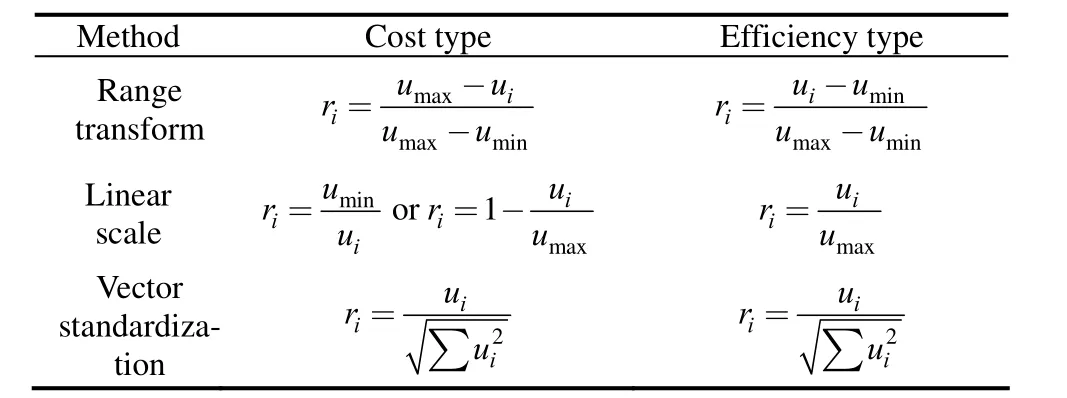
Table 1. Standardized methods of cost-type attributes and efficiency-type attributes
Fixed-type attributes standardized method can be defined as follows[13]:

where c—The fixed value,
umax—The maximum of attributes,
umin—The minimum of attributes.
Interval-type attributes standardized method can be defined as
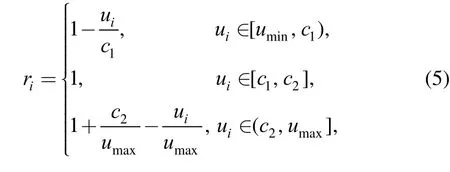
where c1—The fixed value,
c2—The maximum of attributes.
A linear scale transformation is used to normalize the data, so that their sum is equal to 1. The values of the line are divided by the sum. Thus, the normalized matrix can be formed as


The information entropy vector attributes can be formed:

Then the entropy weight vector of attributes can be calculated through the following formula:

Then the weight average operator M(+, •) has been introduced, which takes ‘‘+” and ‘‘•” to replace ‘‘v” and‘‘^”, respectively. Therefore MPE value vector of actuators is obtained through the following formula:
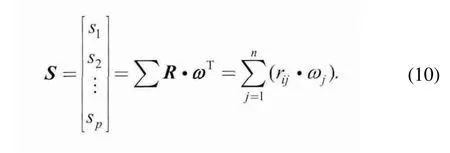
Finally the final ranking of actuators can be gained through sorting the comprehensive value vector S from big to small.
3.2 Case study of actuators’ MPE algorithm
The actual workpiece transmission conditions in the automatic line in a manufacture factory (e.g.) are as follows.
(1) Workpiece mass in the horizontal direction is 5 kg.
(2) Workpiece mass in the vertical direction is 2 kg.
(3) Reciprocating working frequency is 5 times per minute.
According to the working condition of actuators above all, pneumatic and electric actuators are selected. The mechanical properties of these actuators are shown in Table 2.
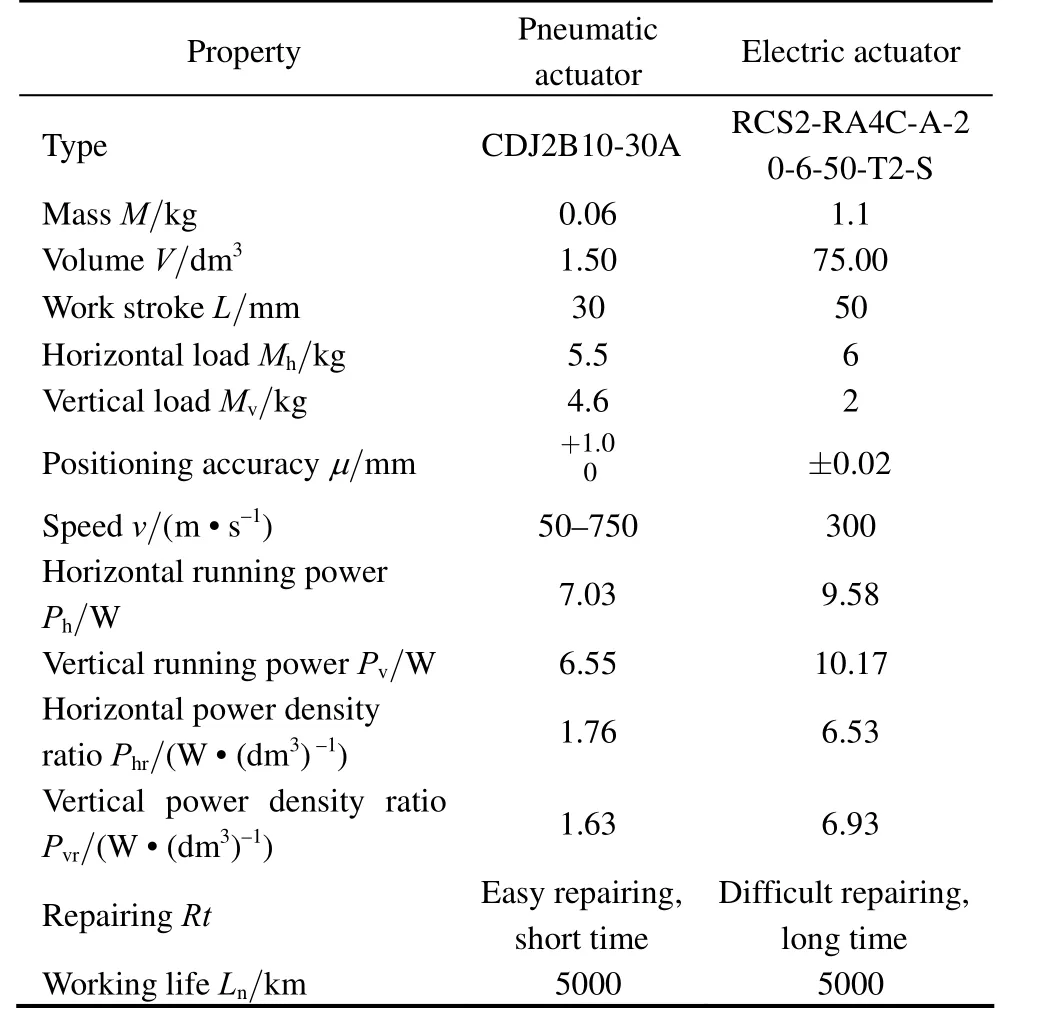
Table 2. Mechanical properties of pneumatic and electric actuators
Running power of pneumatic actuator and electric actuator in the horizontal or vertical direction was obtained from energy consumption experiment of the actuators[14].Repairing feature of the two kinds of actuators was gained from experiences about working field of the actuators.
With the MPE algorithm, the two actuators’ final ranking is (0.78, 0.33). Therefore, the MPE value of the pneumatic actuator is greater than one of the electric actuator. In the actual working field with the same working conditions, the pneumatic actuator is really more popular than the electric actuator in their application number.
4 LCCABOU of Pneumatic and Electric Actuators
When pneumatic actuator reciprocates linear motion, it will consume compressed air which is produced by compressors. Compressors consume some electricity and exhaust a certain amount of compressed air. The production of compressed air can be one of the expensive processes in the manufacturing facilities. Pneumatic actuator can’t work normally if there are not compressors, after coolers,receivers, air filters, solenoid valves and governor valves,and so on[15].
Electric actuator consumes electricity directly. Electric actuator transits workpiece from one point to the other according to the control signal of PC, PLC or special controller. Servo motor and controller are the main energy-consumption parts.
The production of compressed air can be one of the expensive processes in the manufacturing facilities.Pneumatic actuators’ consumption of compressed air is at a cost. And compressed air loss in pipeline network will eventually become heat emissions into the atmosphere[16].Pneumatic actuators, how to calculate its running cost?How to calculate overall life cycle cost of pneumatic actuators? These problems have not been analyzed and discussed by scholars both at home and abroad.
4.1 Energy consumption analysis of pneumatic actuator
When pneumatic actuator retracts or stretches the piston rod, it both consumes a certain amount compressed air. Air consumption amount of pneumatic actuator can be calculated with its mechanical sizes and the pressure of compressed air as follows:

where Qa—Consumption flow of actuator (m3/min),
Va—Consumption volume per time (m3),
Sa—Piston area without rod (mm2),
Sb—Piston area with rod (mm2),
L—Working stroke of actuator (mm),
n—Reciprocating times per minute of actuator,
p—Absolute pressure of compressed air (Pa),
pa—Absolute pressure at the standard condition(Pa),
Fig. 4 describes the main mechanical sizes of general pneumatic actuators.
Specific energy of compressor is calculated by
Pc—Rated power of compressor (kW),
Qc—Rated flow of compressor (m3/min).
Pneumatic actuator can’t work without compressed air.Common pneumatic actuator application field is described as the following Fig. 5.
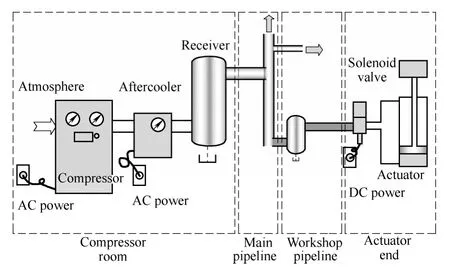
Fig. 5. Common pneumatic actuator application field
Energy consumption of pneumatic actuator can be calculated by

where Ep—Energy consumption of actuator (kW • h),
a—Specific energy of compressor ((kW • h)/m3),
θ—Average air leakage rate of whole compressed air pipeline network (common 10%–30%) (%),
n—Reciprocating times per minute of actuator.
Average air loss rate of pipeline network can be measured by the isothermal cavity deflating air method(ICDAM). The method is to calculate the pipeline total leakage volume by measuring the deflated pressure change with time. Calculation formula is

where Ql—Leakage flow (m3/min),
p1—Absolute pressure of pipeline at the begin time(Pa),
p2—Absolute pressure of pipeline at the end time(Pa),
V0—Total volume of pipeline network (m3),
R—Air constant, R=287 N • m/(kg • K),
T—Room temperature (K),
ρ—Air density at the standard condition (kg/m3),
t—Deflating air time (min).
Then the leakage rate of pneumatic system can be calculated by

4.2 LCCABOU model
Nowadays, LCC methods are all based on the whole life cycle of production, which includes production design cost, manufacturing cost, marketing cost, running cost,repairing cost and scrapping and reclaiming cost, etc.However, for product users, what they are concerned more about are product acquisition cost, energy consumption cost& efficiency and the proportion of the repairing and maintenance cost. Pneumatic or electric actuators must obtain advantage for winning victory in the market in the whole life cycle cost from purchasing to recycling[17–20].This kind of analysis method is named as life cycle cost analysis based on users (LCCABOU). LCCABOU has three main parts: (1) acquisition cost, (2) energy consumption and maintenance cost, (3) recycling cost.
The total cost based on LCCABOU is

where C—Total cost of actuator,
C1—Acquisition cost of actuator,
C2—Running energy consumption and maintenance of cost actuator,
C3—Recycling cost of actuator,
n—Life depreciation period of actuator,
Acquisition cost of actuator belongs to fixed asset investment. Fixed assets exists depreciation problem. Most enterprises adopt the double declining balance method in order to withdraw cost as soon as possible.
In general, different products have the different depreciation lives. Chinese laws and regulations have a clear explanation. The new tax law of China in 2008:machines, machinery and other production equipment depreciation lives are 10 years; electronic equipment is 3 years. General pneumatic components, pneumatic or electric actuator depreciation lives are 5 years. Pipelines,gas tank and compressor depreciation lives are 10 years.
The annual depreciation rate of common device is

where n—Useful life of device,
x—Annual depreciation rate of device.
Depreciation amount of common device in i years is
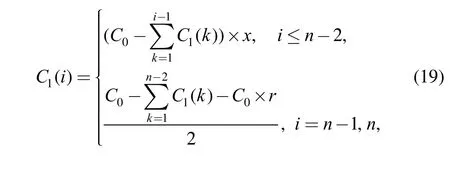
where C0—Acquisition cost of devices,
C1(i)—Depreciation amount of device in i years,r—Estimated net residual value rate of device.
By analyzing Eq. (19), annual depreciation of fixed assets factor β can be deduced:
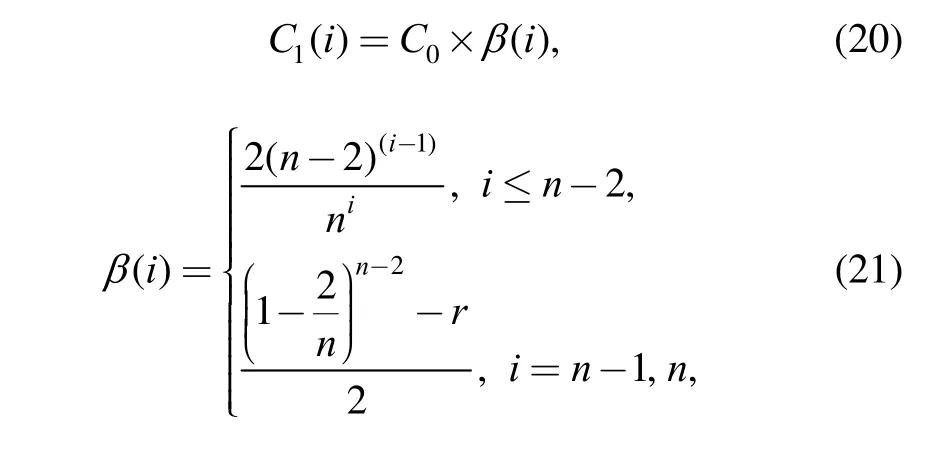
where β(i)—Device depreciation factor in No. i year.
4.3 LCCABOU of pneumatic actuator
In the pneumatic system, there are many pneumatic actuators, nozzle, etc. How will acquisition cost of public devices, such as compressors, aftercooler, receiver, pipeline,etc, be divided into end devices? Public device cost even method (PDCEM) of pneumatic actuator is proposed to solve this problem. We can divide acquisition cost of these public devices into end devices according to the proportion of air consumption of pneumatic actuator in total air consumption of the whole factory according to the PDCEM.
Acquisition cost of pneumatic actuator is

where Ca—Depreciation cost of pneumatic actuator,
Cb—Allocated depreciation cost of workshop pipeline,
Cc—Allocated depreciation cost of main pipeline,
Cd—Allocated depreciation cost of compressor room.
According to Fig. 5, depreciation cost of pneumatic actuator in the end is

where Ca1—Acquisition cost of pneumatic actuator,
Ca2—Acquisition cost of control valves,
Ca3—Acquisition cost of end pipeline,
Ca4—Acquisition cost of solenoid valve,
Ca5—Acquisition cost of air filter.
In workshop pipeline, the allocated depreciation cost about the actuator is

where Cb1–Cb4—Acquisition cost, such as pipeline,receiver, stop valve and air filter in workshop devices,
V(i)—Air consumption of the actuator in i years,
Vw(i)—Air consumption of the workshop in i years,
θw—Average air leakage rate of workshop.
In main pipeline, the allocated depreciation cost about the actuator is

where Cc1–Cc3—Acquisition cost, such as pipeline, stop valve and air filter in main pipeline,
Vc(i)—Air consumption of main pipeline in i years,
θc—Average air leakage rate of main pipeline.
In compressor room, the allocated depreciation cost about the actuator is

where Cd1–Cd3—Acquisition cost of compressor room,such as compressors, air-coolers,receivers,
Vd(i)—Exhaust volume of compressor room in i years,
θd—Air leakage rate of compressor room.
Energy consumption and maintenance cost of pneumatic actuator is

where C21—Energy consumption cost of actuator,
C22—Maintenance cost of actuator.
Energy consumption cost of actuator is

where Ep—Energy consumption cost of actuator,
Evalve—Energy consumption cost of valve,
EPLC—Energy consumption cost of PLC,
e—Electricity cost.
Maintenance cost of actuator is

where Mc—Maintenance cost of compressors,
Mother—Maintenance cost of other devices.
Recycling cost of pneumatic actuators is

where Ch—Handling cost of actuator,
Cr—Recycling material cost of actuator.
4.4 LCCABOU of electric actuator
LCCABOU of electric actuator is easier than pneumatic actuator.
Acquisition cost of actuator is

where Cea—Depreciation cost of electric actuator,
Ceb—Depreciation cost of controller.
Energy consumption and maintenance cost of electric actuator is

where Ce21—Energy consumption cost of electric actuator and controller
Ce22—Maintenance cost of electric actuator and controller.
Recycling cost of electric actuator is similar with one of pneumatic actuator.
4.5 Case study of two kinds of actuators’ LCCABOU
Main cost data of pneumatic and electric actuators are listed in Tables 3–8.

Table 3. Selection and load of pneumatic actuators

Table 4. Selection and load of electric actuators

Table 5. Working conditions of actuators

Table 6. Acquisition cost of pneumatic actuators
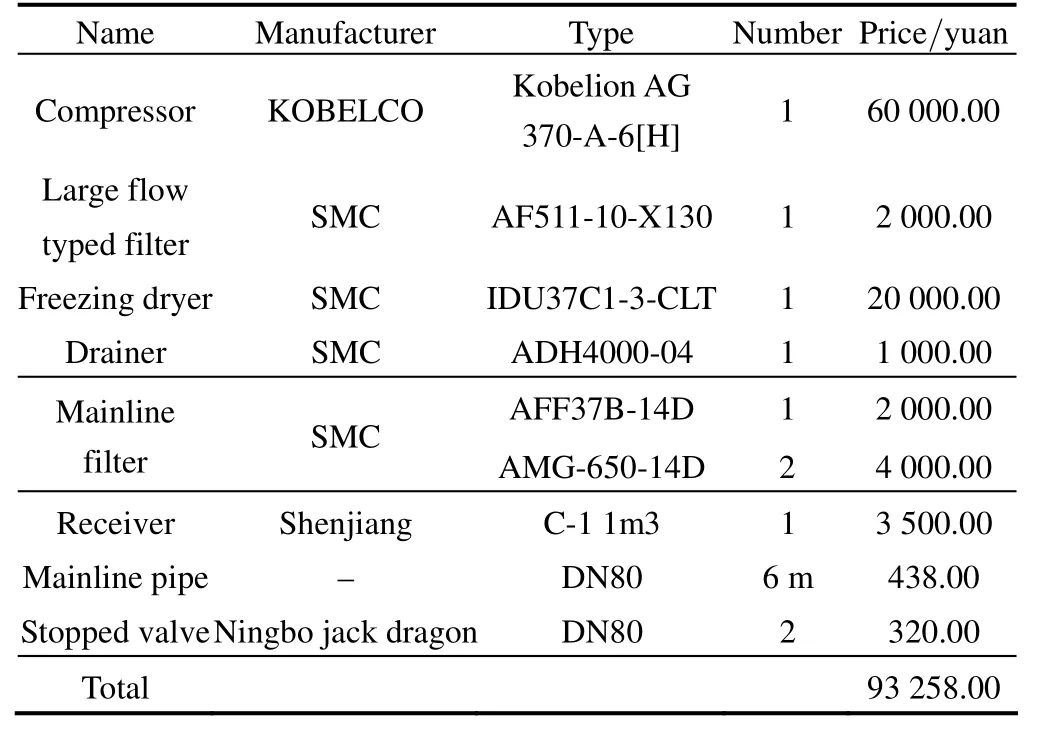
Table 7. Air source devices cost of pneumatic actuators
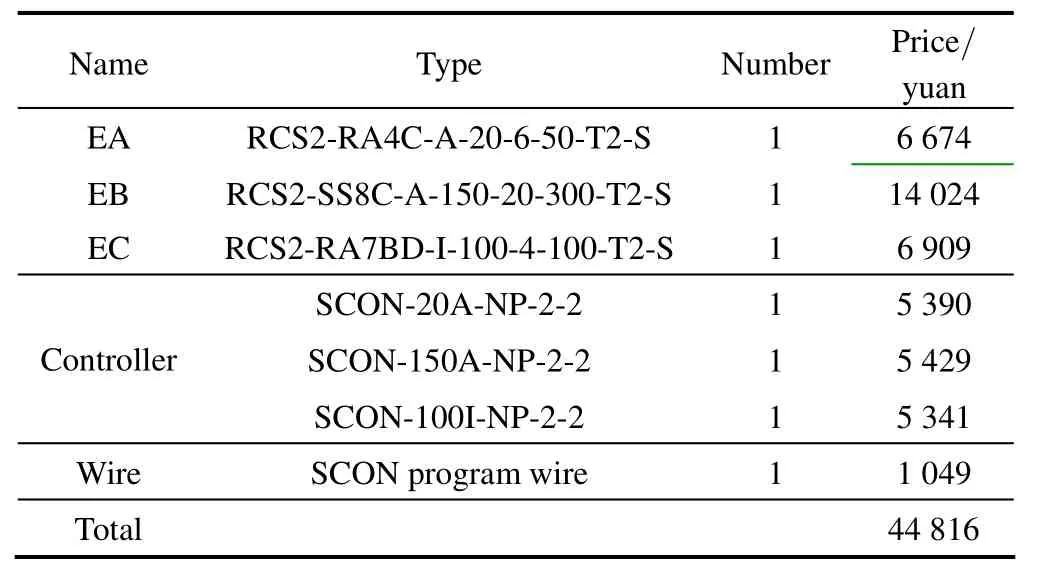
Table 8. Acquisition cost of electric actuators
Energy consumption data of pneumatic and electric actuators in the working time can be obtained from Ref.[14].
According to the LCCABOU, Total cost and accumulative cost of pneumatic and electric actuators in the horizontal working condition are shown in Fig. 6 and Fig. 7. In the vertical working condition, figures are similar with Fig. 6 and Fig. 7. Therefore they are not shown because of limited pages. Fig. 8 describes the ratio of energy consumption and maintenance cost to total cost in life cycle for actuators. The average ratio of pneumatic actuators is about 30% and the average ratio of electric actuators is about 4%.
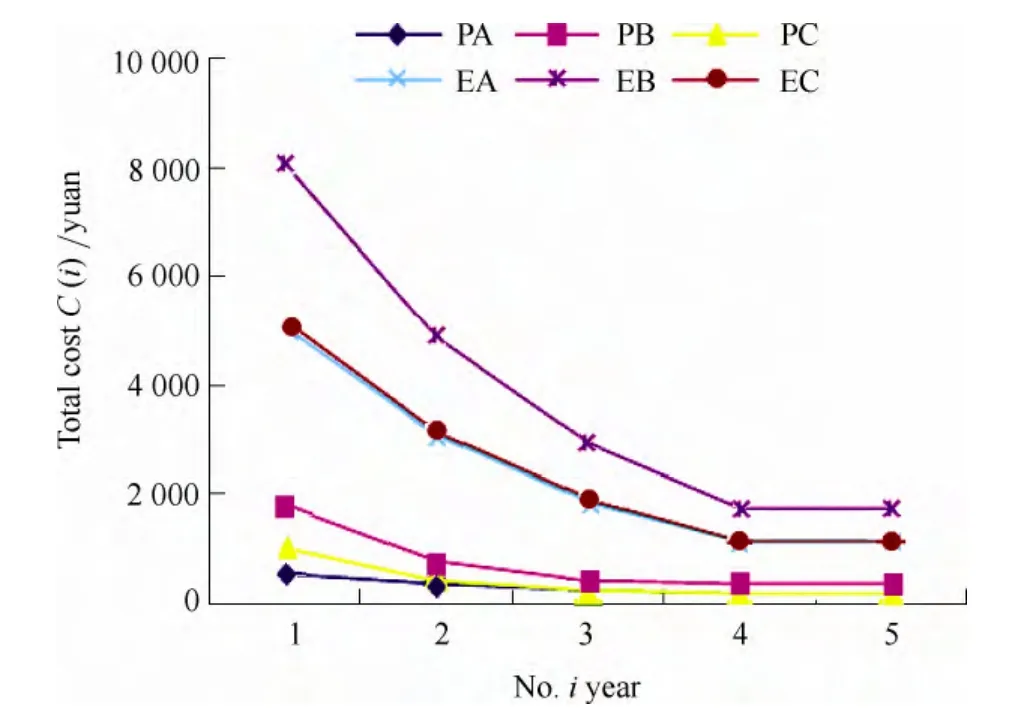
Fig. 6. Total cost in the horizontal of actuators
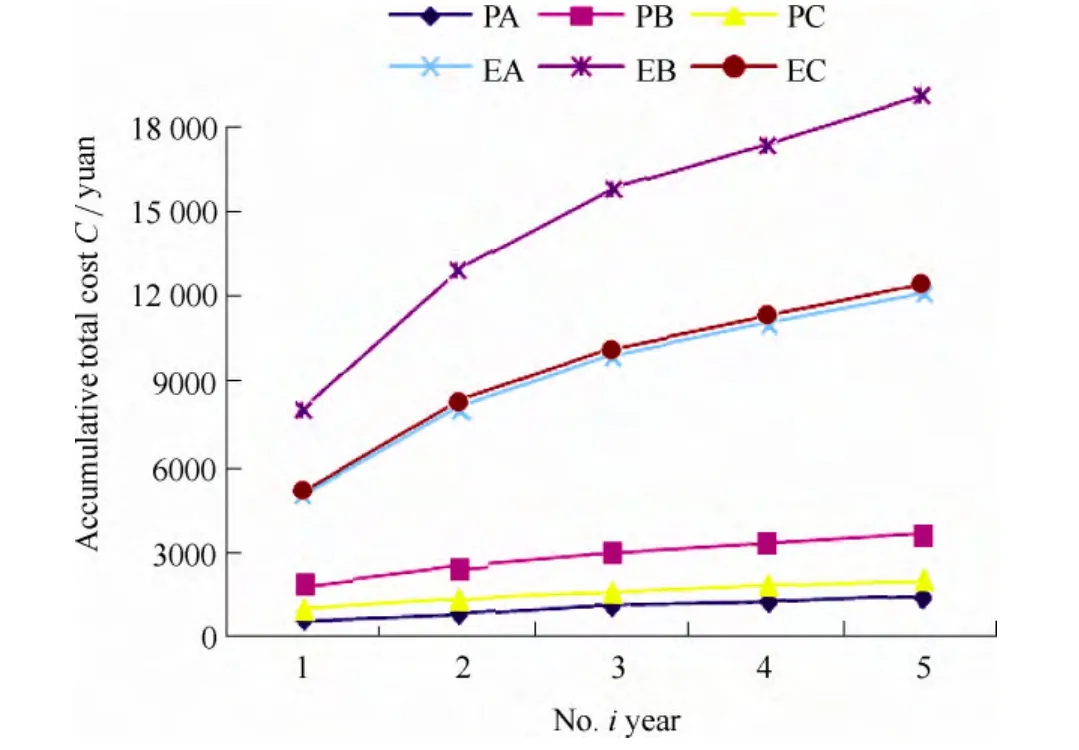
Fig. 7. Accumulative total cost in the horizontal of actuators
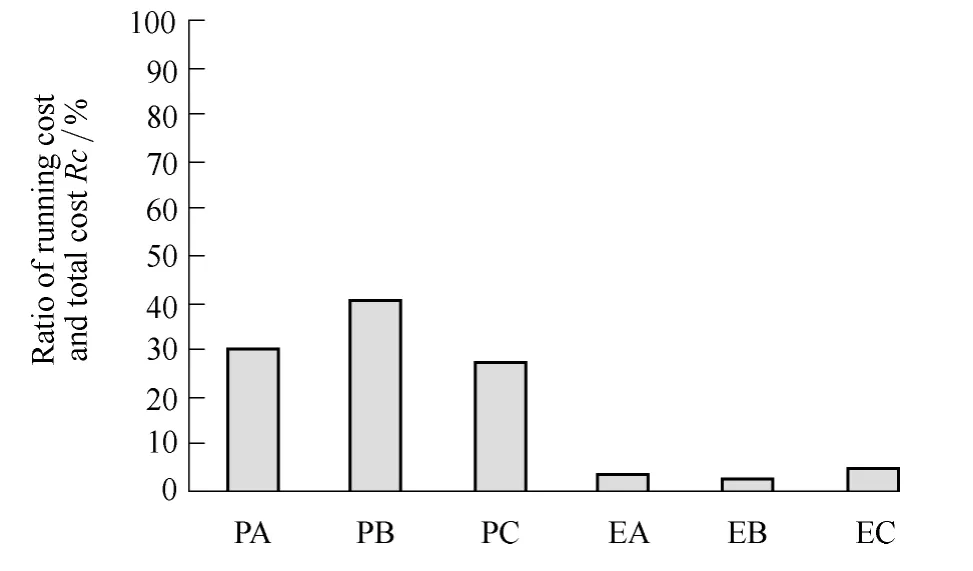
Fig. 8. Ratio of energy consumption and maintenance cost to total cost in life cycle for actuators
5 LCEIA of Pneumatic and Electric Actuators
LCA (known as “life cycle analysis”, “ecobalance”, and”cradle-to-grave analysis”) is the investigation and evaluation of the environmental impact of a given product or service[17]. The goal of LCA is to compare the full range of environmental and social damages assignable to actuators, to be able to choose the least burdensome one. At present it is a popular way to account for the effects of the cascade of technologies responsible for actuators[22–24].
Common categories of assessed damages in LCA are global warming (greenhouse gases), acidification (soil and ocean), smog, ozone layer depletion, eutrophication,eco-toxicological and human-toxicological pollutants,habitat destruction, desertification, land use as well as depletion of minerals and fossil fuels. The procedures of LCA are part of the ISO 14000 environmental management standards: in ISO 14040:2006 and 14044:2006[25].
Pneumatic and electric actuators’ LCEIA is mainly based on life cycle assessment (LCA). LCEIA prefers to the notion that a fair, holistic assessment requires the assessment of raw material production, manufacture,distribution, use and disposal including all intervening transportation steps necessary in the actuators’ overall life cycle with ISO standards and PAS2050 (carbon footprint standard in 2008). With the LCA software Simapro 7.0,environmental impact and carbon footprint of pneumatic and electric actuators can be obtained and different products can be compared with each other to find out the better environment friendly product if they have similar product functions.
5.1 Environmental impact data collection of actuators
In the LCEIA of actuators, system boundary must be first determined. The whole production process of actuators in a certain factory is the manufacturing boundary of actuators. And the running boundary of the actuator is its working condition in a certain industry field. Its recycling boundary is based on the municipal average recycling technique.
Material data and running energy consumption of actuators will be obtained from the manufacturing and application field or some experimental data published in the thesises. Production data analysis of actuators in LCEIA is shown in Fig. 9.

Fig. 9. Production data analysis of actuators in LCEIA
5.2 LCEIA of pneumatic and electric actuators
With environmental data of the actuators, such as material, manufacturing technics, running energy, recycling experience, LCEIA of actuators can be established by Simapro 7. LCEIA model creation procedure of actuators is shown in Fig. 10.
With the assessment of eco-indicator 99 (H), three kinds of electric actuators and three kinds of pneumatic actuators are compare in each category of assessed damages and in single score in Fig. 11 and Fig. 12.
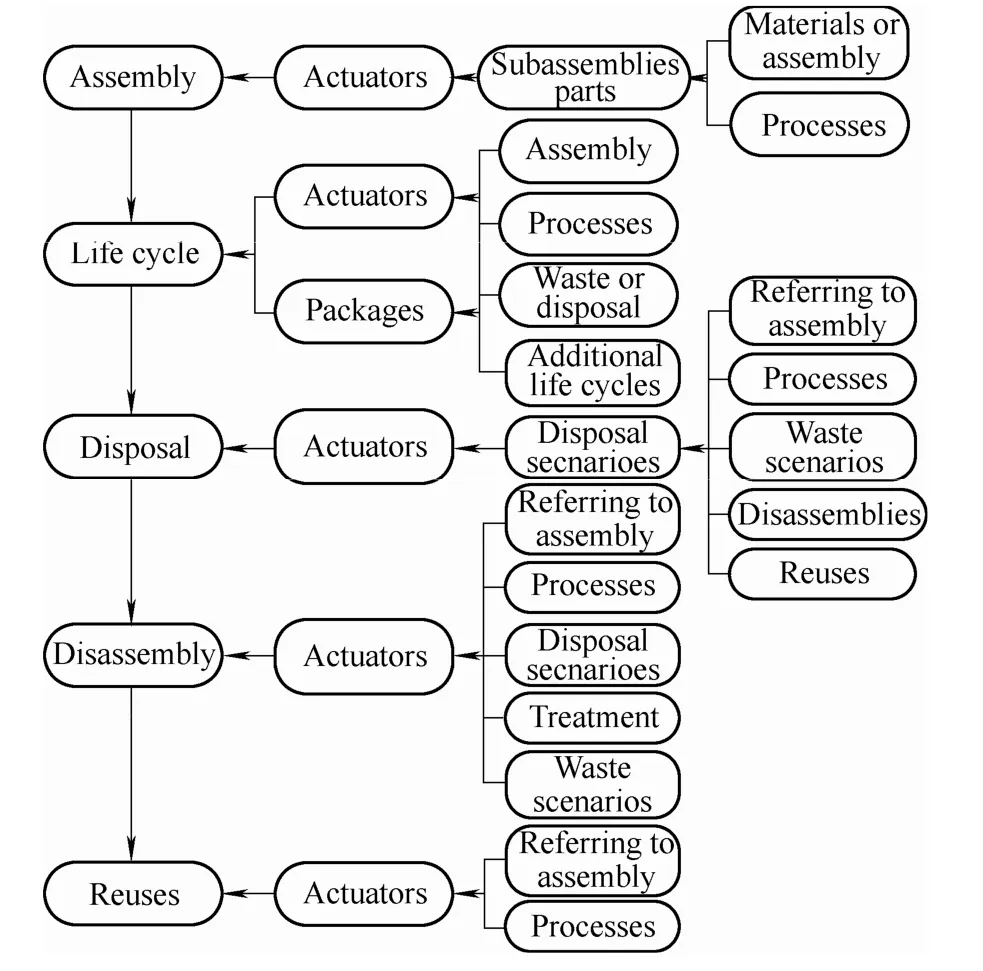
Fig. 10. LCEIA model creation procedure of actuators
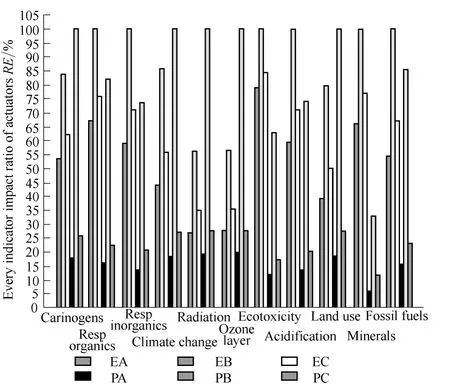
Fig. 11. Six actuators’ LCEIA comparison in each category
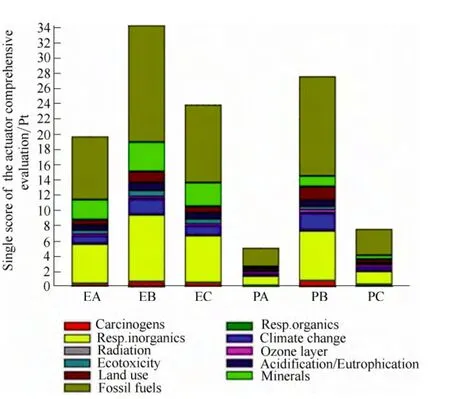
Fig. 12. LCEIA comparison in single score of six actuators
From Fig. 11 and Fig. 12, we can find that the fossil fuel and the mineral of electric actuator B is the most and the climate change of pneumatic actuator B is the most. These characteristics accord with the mechanical properties of these actuators. Therefore, the result of actuators LCEIA is reasonable.
6 Conclusions
(1) OLCCA, a new comprehensive assessment method,is first proposed for pneumatic and electric actuators’comparison and assessment. OLCCA contains three main assessment methods for mechanical properties, cost and environmental impact: MPE, LCCABOU, and LCEIA algorithm. Under the similar mechanical properties and working conditions of pneumatic and electric actuators,the performance of electric actuator is better than one of pneumatic actuator , the cost of electric actuator is more expensive than one of pneumatic actuator, and environmental impact of electric actuator is greater than one of pneumatic actuator.
(2) Mechanical properties evaluation of the actuators is a multi-objective optimization problem. The fuzzy data quantification and information entropy methods are combined to establish the MPE algorithm of actuators.Case study of the algorithm is carried out to verify its correctness. The result shows it is effective, useful and easy to apply.
(3) In order to describe life cycle cost of pneumatic actuators objectively, LCCABOU of actuators is set up.Considering complex cost structure of pneumatic actuators,PDCEM is firstly presented to solve public devices cost division of the actuators, such as compressors, receivers,etc. Life cycle cost of pneumatic actuator is particularly described by many formulas based on LCCABOU. Finally,case study also verified the LCCABOU method is useful and reasonable.
(4) LCEIA model of actuators is established for six actuators’ environmental impact assessment based on LCA.Actuators’ LCEIA data collection procedure is also put forward. Six actuators’ LCEIA data collection spent a large amount time in order to describe material and energy consumption of the actuators correctly. With Simapro 7,LCEIA comparison result of six actuators is gained; and it is correct and corresponds with the mechanical properties of the actuators.
[1] MATTIAS Höjer, SOFIA Ahlroth, KARL-HENRIK Dreborg, et al.Scenarios in selected tools for environmental systems analysis[J].Journal of Cleaner Production, 2008, 16(8): 1958–1970.
[2] FERREIRA FJTE, FONG JAC, DE ALMEIDA A T. Ecoanalysis of variable-speed drives for flow regulation in pumping systems[J].IEEE Transactions of Industrial Electronics, 2011, 58(6): 2117–2125.
[3] SOfiA Ahlroth, MÅNS Nilsson, GÖRAN Finnveden, et al.Weighting and valuation in selected environmental systems analysis tools - suggestions for further developments[J]. Journal of Cleaner Production, 2011, 19(2–3): 145–156.
[4] NNA Lewandowska. Environmental life cycle assessment as a tool for identification and assessment of environmental aspects in environmental management systems (EMS) part 1: methodology[J].International Journal of Life Cycle Assessment, 2011, 16(2):178–186.
[5] ANNA Lewandowska. Environmental life cycle assessment as a tool for identification and assessment of environmental aspects in environmental management systems (EMS) part 2: case studies [J].International Journal of Life Cycle Assessment, 2011, 16(3):247–257.
[6] EUN Jong-Hwan, SON Ji-Ho, MOON Jeong-Min, et al. Integration of life cycle assessment in the environmental information system[J].Journal of Life Cycle Assessment, 2009, 14(4): 364–373.
[7] ZHANG Yeming, CAI Maolin, KONG Dewen. Overall energy efficiency of lubricant-injected rotary screw compressors and aftercoolers[C]//Asia-Pacific Power and Energy Engineering Conference, Wuhan, China, March 28–31, 2009: 2266–2270.
[8] CAI Maolin, CHEN Xiangyu, WANG Xiongyao, et al. Competition and complementary of cylinders and electric actuators[J]. Modern Manufacture, 2009(4): 24–27. (in Chinese)
[9] LIU Li, ZHOU Jianzhong; AN Xueli, et al. Using fuzzy theory and information entropy for water quality assessment in Three Gorges region, China[J]. Expert System with Applications, 2007, 37(3):2517–2521.
[10] PENG Haijun, SUN Qiguo. Mechanical products quality multiple decisionbased on information entropy[J]. Machinery Design &Manufacture, 2007(4): 139–140. (in Chinese)
[11] ATHANASOPOULOS G, RIBA C R, ATHANASOPOULOU C. A decision support system for coating selection based on fuzzy logic and multi-criteria decision making[J]. Expert System with Applications, 2009, 36(8): 10 848–10 853.
[12] YANG Yuzhong, WU Liyun. Fuzzy synthetic evaluation on safety of fully mechanized mining faces based on entropy weight[C]//5th International Conference on Fuzzy Systems and Knowledge Discovery, Jinan, China, October 18–20, 2008: 391–395.
[13] LIU Hua, CHEN Weiping, ZHAO Haidong, et al. Evaluation on approxiamtion to utility function of green product[J]. Chinese Journal of Mechanical Engineering, 2005, 41(10): 17–22. (in Chinese)
[14] ZHANG Yeming, CAI Maolin. Energy consumption analysis for pneumatic actuator and electric actuator[J]. Journal of Beijing University of Aeronautics and Astronautics, 2010, 36(5): 560–563.(in Chinese)
[15] CAI Maolin, KAGAWA T. Energy consumption assessment and energy loss analysis in pneumatic system[J]. Chinese Journal of Mechanical Engineering, 2007, 43(9): 69–74. (in Chinese)
[16] CAI Maolin, KAWASHIMA Kenji, KAGAWA T. Power assessment of flowing compressed air[J]. Journal of Fluids Engineering, Transactions of the ASME, 2006, 128(2): 402–405.
[17] CHEN Xiaochuan, FANG Minglun. Summaries of product life cycle cost in manufacturiing[J]. Chinese Journal of Mechanical Engineering, 2002, 38(11): 17–25.
[18] DEUTSCH MATTHIAS. Life cycle cost disclosure, consumer behavior, and business implications[J]. Journal of Industrial Ecology, 2010, 14(1): 103–120.
[19] KAENZIG J, WUSTENHAGEN R. The effect of life cycle cost information on consumer investment decisions regarding eco-innovation[J]. Journal of Industrial Ecology, 2010, 14(1):121–136.
[20] ARVIND Chel, TIWARI G N, AVINASH Chandra. Simplified method of sizing and life cycle cost assessment of building integrated photovoltaic system[J]. Energy and Buildings, 2009,41(11): 1172–1180.
[21] LEE J Y, AN S, CHA K, et al. Life cycle environmental and economic analyses of a hydrogen station with wind energy[J].International Journal of Hydrogen Energy, 2010, 35(6): 2213–2225.
[22] FINNVEDEN G, HAUSCHILD M Z, EKVALL T, et al. Recent developments in life cycle assessment[J]. Environmental Management, 2009, 91(1): 1–21.
[23] ANA M Contreras, ELENA Rosa, MAYLIER Pérez, et al.Comparative life cycle assessment of four alternatives for using by-products of cane sugar production[J]. Journal of Cleaner Production, 2009, 17(8): 772–779.
[24] CHOI B C, SHIN H S, LEE S Y, et al. Life cycle assessment of a personal computer and its effective recycling rate[J]. International Journal of Life Cycle Assessment, 2006, 11(2): 122–128.
[25] DUAN Huabo, EUGSTER Martin, HISCHIER Roland, et al. Life cycle assessment study of a Chinese desktop personal computer[J].Science of the Total Environment, 2009, 407(5): 1755–1764.
 Chinese Journal of Mechanical Engineering2014年3期
Chinese Journal of Mechanical Engineering2014年3期
- Chinese Journal of Mechanical Engineering的其它文章
- Theoretical Analysis and Experimental Verification on Valve-less Piezoelectric Pump with Hemisphere-segment Bluff-body
- Carbody Structural Lightweighting Based on Implicit Parameterized Model
- Prediction-based Manufacturing Center Self-adaptive Demand Side Energy Optimization in Cyber Physical Systems
- Effectiveness of a Passive-active Vibration Isolation System with Actuator Constraints
- Numerical Simulation and Analysis of Power Consumption and Metzner-Otto Constant for Impeller of 6PBT
- Proceeding of Human Exoskeleton Technology and Discussions on Future Research
